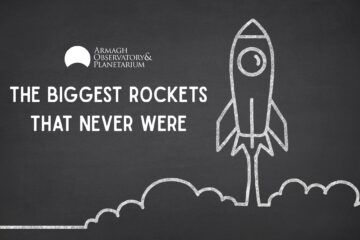Armagh Observatory and Planetarium’s Robinson Lecture this year will be about the Sun. To lead into this here is the first of two articles about why astronomers study our Sun, and the range of telescopes and satellites co-opted to the the task.
Solar physics is the branch of astrophysics that deals with the study of the Sun, our closest star. It involves many other branches of physics, e.g. seismology, plasma physics, atomic physics, nuclear physics, spectroscopy radiative transfer and magnetohydrodynamics, to name a few. The Sun regenerates its entire magnetic field every 22 years, and converts a small amount of this energy into high energy photons and particles flooding the solar system, giving rise to life on Earth. This small fraction of energy from nuclear fusion which is partitioned into magnetic energy exhibits remarkable properties. The changes that are produced in the solar atmosphere result in solar activity which can have a major impact on Earth’s climate, known as space weather. The most explosive phenomena are solar flares, which may have an associated coronal mass ejection.
Solar flares are classified using a scale (B, C, M and X-class, with X-class being the most energetic). Each class has an internal scale from 1 to 9, and moving from one class to the next represents a 10-fold increase in flare strength. The Carrington flare of 1859 had an estimated ranking of around X40. Another large flare in 2003 had a ranking of at least X28. In 1859, the geomagnetic storm only affected telegraph services but with today’s more advanced technology, a comparable event would damage orbiting satellites and spacecraft, and most likely cause widespread blackouts. Regardless of the potential impacts, these previous events would not have qualified as “super-flares”.
Many super-flares on solar-type stars (G-type main sequence stars) have been observed by the Kepler/K2 space telescope. The bolometric energy released by the super-flare is a factor of 10 to 10,000 (i.e. X10 to X10000) greater than the largest solar flares. If super-flares were to occur on the Sun (accompanied by a super Coronal Mass Ejection), they would cause very serious damage to our civilisation, e.g. it is estimated that a X1000 flare would produce particles with energies about 10 billion times greater than visible light, which would result in drastic increase in the radiation level in the Earth’s atmosphere.
However, we currently cannot answer many fundamental questions, such as “What is the largest flare energy that a star can produce?” and “How are such large flares generated?” This lack of understanding is rooted in two facts; larger flares occur less frequently and there is a lack of statistics on flares. Solar-type stars producing super-flares must have a large spot coverage (of 1-10% the surface). However, the spot coverage on the Sun as observed over the past three hundred years is only a fraction of this. An interesting drawing of the Sun taken from the Chronicles of John of Worcester dating from 1128 shows two large spots, each with a clearly extended pre-umbra region, which begs the question of whether our Sun has in the recent past produced super-large spots capable of super-flare activity? It is estimated that the average occurrence rate of a X100 super-flare on stars with similar rotation period to the Sun is about once in 800 years.

Sunspot drawing in 1128 by John of Worcester (SourceL Wikipedia from John of Worcester (1128). The Chronicle of John of Worcester (MS 157 ed.). Corpus Christi College, Oxford: John of Worcester. p. 380.)
In the second article (available from Nov 15) we will describe some of the telescopes and satellites now being used to study the Sun.
Article written by: Gerry Doyle, Research Astronomer





4 Comments
Telescopes and Satellites for studying the Sun – The Science Page · November 15, 2017 at 09:01
[…] telling us about the Sun, in part two of this posting Armagh astronomer Gerry Doyle takes us through the telescopes and […]
Telescopes and Satellites for studying the Sun | Astronotes · November 15, 2017 at 09:00
[…] telling us about the Sun, in part two of this posting Armagh astronomer Gerry Doyle takes us through the telescopes and […]
The 2018 Robinson Lecture: Professor Louise Harra tells us about how astronomers research the Sun | Astronotes · November 12, 2017 at 19:39
[…] post will also be followed by two articles written by Armagh Astronomer Gerry Doyle (available Nov 8 and 15, respectively) telling us more about the Sun and why we study […]
Why study the Sun? – MeasurementDataBases for Industry & Science · November 8, 2017 at 09:58
[…] Astronotes Astronotes: Armagh Observatory and Planetarium’s Robinson Lecture this year will be about the […]